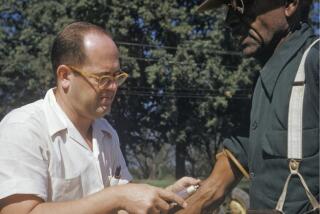1 in 4 Young Blacks in Jail or in Court Control, Study Says
WASHINGTON — One of four black men in their 20s is in jail, in prison or otherwise under the control of criminal courts through probation or parole, according to a crime data analysis released Monday.
With prison sentencings increasing, more black men in their 20s are under court control than there are black men of all ages in higher education, the report found.
By contrast, about 6% of white men in their 20s are being held or supervised by the criminal courts, and more than four times as many white men are in college as are under court control.
The study was released by the Sentencing Project, a Washington nonprofit group that lobbies for alternatives to incarceration. Using Justice Department crime data, it counted only those convicted of crimes--not just arrested--so the level of actual criminal activity was greatly understated, its authors said.
Criminal justice experts and black officials said the figures illustrate two trends. Since the mid-1970s, most states and the federal government have adopted get-tough sentencing laws that have forced judges to impose prison terms for certain crimes, including drunk driving and the selling of drugs.
Secondly, the drug trade has overwhelmed many urban black communities, wiping out legitimate businesses and steering young men to crime.
This is an “extremely grim picture facing black males,” said Julius Chambers, executive director of the NAACP Legal Defense Fund. “As a nation, we have failed to look at this problem and to address it.”
Said Marc Mauer, author of the report: “We now risk the possibility of writing off an entire generation of black men from leading productive lives. This has ominous implications for the black community. We really don’t know what it will mean for the future because we have never had a situation like this before.”
It was not known whether the percentages of blacks, whites and others under court control are increasing because comparative figures were not available.
However, law enforcement experts said they believe that they are and said the group’s statistical analysis appears to be accurate. “They’ve made some reasonable projections, so I think the numbers are correct,” said Joseph Bessette, acting director of the Bureau of Justice Statistics.
The new report estimated that 1 in 10 Latino males in their 20s is under the control of the criminal courts, but it stressed that the figures are much less reliable, in part, because of uncertainty about the size of the illegal population.
A series of recent reports has documented that crime is pervasive in black neighborhoods. In 1987, the California Department of Justice estimated that 40% of black males between the ages of 18 and 29 had been arrested for a serious offense.
The report issued Monday does not try to explain why so many black men are arrested and convicted of crimes, but its authors contend that too many of them are locked up.
Mauer favors alternatives, such as forcing criminals to repay their victims and to work in community service projects. The large prison populations pose a huge and unjustified cost burden, he said, and incarceration ruins the lives of offenders who could otherwise be rehabilitated.
But legislatures and state parole boards have increasingly frowned on programs that let inmates out of prison. “Work furloughs had a very good track record, but all it took was one Willie Horton and one presidential campaign to blow that idea out of the water,” Mauer said, referring to George Bush’s anti-crime ads citing a Massachusetts inmate.
In the last decade, the number of persons in federal and state prisons has more than doubled. In 1980, about 330,000 persons were in prison. By mid-1989, the total had reached 670,000, according to the Justice Department.
The new report shows that about two-thirds of the 609,690 young black males under court control are out on probation or parole. However, it shows also that, although blacks make up only 12% of the overall population, slightly more black inmates than whites are now housed in state prisons.
Chambers, the NAACP lawyer, said that discrimination in the criminal justice system is partly to blame. “I don’t think there’s any doubt about that. It is still a white system: white judges, white prosecutors and white juries,” he said.
But Joan Petersilia, a crime expert at the RAND Corp. in Santa Monica, said her studies of criminal punishments show that whites are just as likely as blacks to be sent to prison for the same crime. “The research shows that racial discrimination in sentencing is not the explanation. They (black males) simply commit more of the crimes that lead to imprisonment,” she said.
However, she said it is possible that black males are more likely than whites to be arrested for the same crime. “There is a greater police presence in minority communities, so the probability of getting picked up for a crime is greater,” she said.
According to the analysis, far fewer women than men are convicted of crimes and are put under the control of the courts. Of those, black women are far more likely than whites to come into the criminal courts. About 2.7% of black females in their 20s are under court control, compared to 1.8% of Latino females and 1% of white females of the same age.
Officials of the Sentencing Project, a small group funded by several foundations, said they hope their report will spur debate about the get-tough approach to crime, and, in particular, the Bush Administration’s strategy in the war on drugs.
“We have doubled the incarceration rate, doubled the prison population and what do we have to show for it?” asked Malcolm Young, executive director of the Sentencing Project.
Rep. John Conyers Jr. (D-Mich.) agreed, noting that it cost an estimated $2.5 billion a year to imprison and monitor the black males under the court’s control. “Surely, we as a nation can aspire to more with this money than punish and continue a vicious cycle of hate and despair,” Conyers said.
Several California activists who work with black youths said that better education and job opportunities could reduce the crime rate.
“If you increase the opportunities or avenues towards opportunity, the crime will decrease,” said William Cavil, associate director of the Oakland-based Institute for the Advanced Study of Black Family and Culture, which has a training and development program for black adolescents. “When you increase the number of jobs, the educational opportunities, you’ll decrease the number of black men in jail.”
Leon Watkins, who heads a family help hot line in South Los Angeles, explained that many young men say to themselves: “I don’t have anything. I can’t get a job, I tried to get an education and I couldn’t (but) I’m going to get mine . . . . That’s what society projects, getting gold cards and all kinds of things they know they’ll never get. So they take it.”
Added Chilton Alphonse, executive director of the Community Youth Sports and Arts Foundation, which runs a school and home for at-risk youth: “With the influx of cocaine into the black community, many youngsters see that as the only way out. Because they’ve been ignored by the system, they’ve lost hope. And, once they reach that point, you have a serious dilemma, because, if they see no way of getting a piece of the pie, then they’ll resort to any means necessary for survival. And in many instances that means criminal behavior.”
Staff writers Charisse Jones in Los Angeles and William J. Eaton in Washington contributed to this story.
YOUNG ADULTS IN THE JUSTICE SYSTEM: BY RACE
One in four black men between 20 and 29 are in prison, in jail or otherwise under the control of criminal courts through parole or probation. By contrast, about 6% of white males in their 20s are under the control of a criminal court. While far fewer women than men in this age group are under court control, a far higher percentage of black women than whites are in prison or jail.
MALES
State Federal Prisons Jails Prisons Probation Parole Total Rate White 138,111 94,616 15,203 697,567 109,011 1,054,508 6.2% Black 138,706 66,188 7,358 305,306 92,132 606,690 23.0 Hispanic 36,302 24,357 6,155 134,772 36,669 238,255 10.4 TOTAL 1,902,453 8.4
FEMALES
State Federal Prisons Jails Prisons Probation Parole Total Rate White 6,320 7,099 944 141,174 8,712 164,249 1.0 Black 6,072 6,095 655 58,597 6,988 78,417 2.7 Hispanic 1,509 2,036 488 29,850 3,210 37,093 1.8 TOTAL 279,759 1.3
Source: The Sentencing Project
More to Read
Sign up for Essential California
The most important California stories and recommendations in your inbox every morning.
You may occasionally receive promotional content from the Los Angeles Times.











